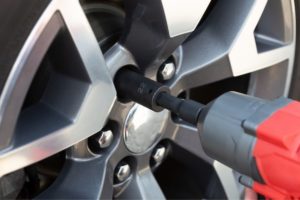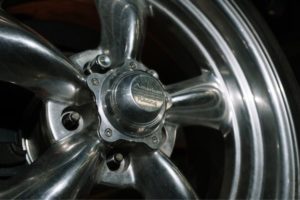Quick Navigation
The Holden car brand has been a significant player in the automotive industry for many decades.

One of the key features of Holden vehicles is their wheel stud pattern.
This refers to the arrangement of the studs that hold the wheel onto the hub of the car.
The number of studs or bolts used to secure a wheel to a vehicle is called a wheel’s stud pattern.
The distance between each stud is measured in millimeters or inches.
It is crucial to know your required stud pattern in order to match the wheel pattern correctly.
Early Holden vehicles had a unique stud pattern that was different from most other car brands.
In this article, we will explore the early Holden stud patterns and explain them for enthusiasts and collectors.
Overview of Early Holden Stud Patterns
Holden vehicles are known for their durability and performance. A key component of these vehicles is the wheel stud pattern.
Here is an overview of the types of early Holden stud patterns and their significance.
Types of Early Holden Stud Patterns
When it comes to wheel stud patterns, there are different measurements to consider.
These all boil down to the PCD (Pitch Circle Diameter) and the center bore of the wheel.
PCD (Pitch Circle Diameter)
The PCD refers to the diameter of the imaginary circle that is created by the center of the wheel studs.
This measurement is important because it determines the number of studs that can be used on a wheel.
It also helps with determining the spacing between them. For example, a 5-stud pattern would have a PCD of 5x100mm.
This means that the studs are 100mm apart and there are 5 of them.
It is important to note that not all vehicles use the same PCD, so it is important to select the correct stud pattern for your Holden vehicle.
Common Early Holden Stud Patterns

Holden Stud Pattern: 4 on 4 1/2 Inch PCD
The 4 on 4 1/2 inch PCD pattern is one of the most common patterns used on early Holden vehicles. This includes the FX, FJ, and FE models.
This stud pattern is characterized by 4 studs or bolts that there are used to secure the wheel to the vehicle.
The distance between each stud is 114.3 millimeters or 4.5 inches.
Commonly, the center-to-center adjacent stud measurement for vehicles with 4 on 4 1/2 Inch PCD is 80.82mm.
Holden Stud Pattern: 5 on 41/2 Inch PCD
The 5 on 41/2-inch PCD stud pattern is another commonly used stud pattern on early Holden vehicles.
This stud pattern was used on models such as the FC and FB series. The 5 on 4 1/2-inch PCD stud pattern features four studs spaced 101.6mm apart.
However, the fifth stud is located in the center of the wheel. This arrangement helps to provide additional support and stability to the wheel.
This stud pattern is used on vehicles to secure the wheel to the hub.
The number and spacing of the studs are critical to ensure proper fit and safe operation of the wheels and tires.
The center-to-center adjacent stud measurement for vehicles with 5 on 41/2 Inch PCD is 67.18mm.
Holden Stud Pattern: 5 on 4 3/4 Inch PCD
The 5 on 4 3/4 inch PCD stud pattern was used on a variety of early Holden models. This included the EK and EJ series.
This stud pattern provides a stronger and more secure connection between the wheel and the vehicle.
Hence, it is ideal for high-performance applications. 5 on 4 3/4 inch PCD means that there are 5 studs spaced at equal intervals 0f 120.7mm around the circumference.
With this stud pattern, the center bore usually measures 70.91mm. Holden HQ HJ HX are all examples of vehicles with a 5 on 4 3/4 Inch PCD stud pattern.
Holden Stud Pattern: 6 on 41/2 Inch PCD
The 6 on 41/2 inch PCD stud pattern was used on some of Holden’s later model vehicles.
The HR and HK series are examples of the vehicles that used the 6 on 4 1/2 inch PCD stud pattern.
This stud pattern features six studs spaced 101.6mm apart, with a center bore of 70.7mm.
The additional studs provide additional support and stability to the wheel, making it ideal for high-performance vehicles too.

Center Bore
The center bore refers to the size of the hole in the center of the wheel that fits over the vehicle’s hub.
Centre bore size is important for proper wheel fitment in all vehicles, including older Holden models.
If the center bore is not the correct size, the wheel may not properly align with the hub.
Consequently, the vehicle would suffer vibration and decreased handling performance.
Older Holden models also have unique center bore requirements. So, it’s important to refer to the manufacturer’s specifications to ensure proper fitment.
Centre bore measurement for older Holden models is typically taken in millimeters.
The correct size for a given vehicle can be found in its manufacturer’s specifications.
To calculate the center bore for a Holden, measure the diameter of the circular opening in the center of the wheel.
Alternatively, reference the manufacturer’s specifications for the size.
It’s important to note that the center bore requirements may vary based on the specific model and year of the Holden.
Therefore, it is important to consult the manufacturer’s specifications to ensure proper fitment.
Choosing the Right Stud Pattern for an Early Holden Model
Factors to Consider When Selecting the Right Stud Pattern for Your Early Holden
When selecting the right stud pattern for an early model Holden car, you should consider the following factors:
- Compatibility: Make sure the stud pattern you choose is compatible with the make and model of your Holden car.
- Original Equipment Manufacturer (OEM) specification: Choose a stud pattern that matches the OEM specifications. You should do this if you want to maintain the original factory specifications of your Holden.
- Wheel offset: The wheel offset refers to the distance between the centerline of the wheel and the mounting surface. The right stud pattern should provide the correct offset for your Holden car.
- Brake clearance: Ensure that the stud pattern you choose provides sufficient clearance for the brake components.
- Tire size: Make sure the stud pattern you choose accommodates the tire size you want to use.
- Suspension type: The suspension type of your Holden car can affect the stud pattern. Make sure to choose a stud pattern that is compatible with your suspension.
- Performance: If you plan on using your Holden for performance driving, consider a stud pattern that can accommodate wider wheels and tires. This will improve handling and traction.
Conclusion
In conclusion, choosing the right stud pattern for your early model Holden car is a decision that requires careful consideration.
Factors such as compatibility, OEM specification, wheel offset, brake clearance, tire size, suspension type, and performance should all be taken into account.
This will ensure the best fit for your vehicle. It is recommended that you consult a specialist or refer to manufacturer specifications before making a final decision.
With the right stud pattern, you can improve the performance, handling, and appearance of your Holden. This will keep it running smoothly for years to come.

James has been a car enthusiast since his childhood when he learned the differences between a ford and a chevy from his father. He loves to drive and restore old cars with a special drive for Italian marvels. Currently, he has a 1968 Alfa Romeo. He has studied aeronautics and civil aviation in his college and still gets smitten by Galant SS and Lancer GSR.
He is a New York-based product training director working with a giant automotive retailer. He loves to review and uncover the vehicles and their fascinating stories. He believes in keeping it legitimate with a keen passion for research on the latest technological upgrades in cars. While reading his articles or blogs, you can sense the extensive research and dedication backing the piece of text. He loves fried chicken, music, and spending quality time with his pet dog.







